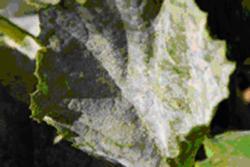Unused stories
Pest of the Month - Powdery Mildew
Seeing Spots?
Cooler temperatures in May 2015 have made gardening a delight but more time out there means more observation of issues. One such is powdery mildew…
If you’ve got white spots on your plants, there’s a good chance that it’s powdery mildew, a common, unsightly garden fungus that affects a wide variety of ornamentals and edibles. There is a common misconception that powdery mildew requires moist conditions. On the contrary, it typically proliferates in warm and dry areas such as those found throughout Marin. The perfect breeding ground for powdery mildew is a shady spot on a 60 to 80-degree day. Powdery mildew spores are carried by the wind, floating freely and invisibly throughout the garden.
How to identify powdery mildew
Powdery mildew is usually more unattractive than it is serious. It typically first appears as white, powdery spots on leaves, shoots and sometimes flowers and fruit. Left unchecked, affected leaves may gradually turn yellow, die and fall off. Powdery mildew is most serious when it attacks vulnerable new growth, often causing disfiguring and dwarfing. Edibles with severe powder mildew infestations may have reduced yields and tasteless fruit. Susceptible plants include squash, cucumbers, beans, tomatoes, strawberries, grapes, roses, dahlias and zinnias. The growing tips of fruit trees also may develop the disease.
Getting rid of powdery mildew
Prevention is your best weapon against powdery mildew. Here’s how to avoid this fungus:
- choose resistant plant varieties
- plant in full sun
- avoid excess fertilizer
- provide good air circulation.
If powdery mildew manages to sneak into your garden, pick off and destroy the infected parts and spray infected plants with water early in the day. If this doesn’t do the trick, try applying neem or jojoba oil. If the fungus persists, you may want to try a sulfur or other type of fungicide. Some gardeners who have struggled with powdery mildew infestations in the past apply sulfur as a preventative. Follow package instructions closely.
To learn more, visit the following University of California Integrated Pest Management pages: Powdery mildew on vegetables and Powdery mildew on ornamentals, and read this article from the Marin IJ on how to combat powdery mildew on plants.
Contributors:
Marie Narlock, Faith Brown, Nanette Londeree
